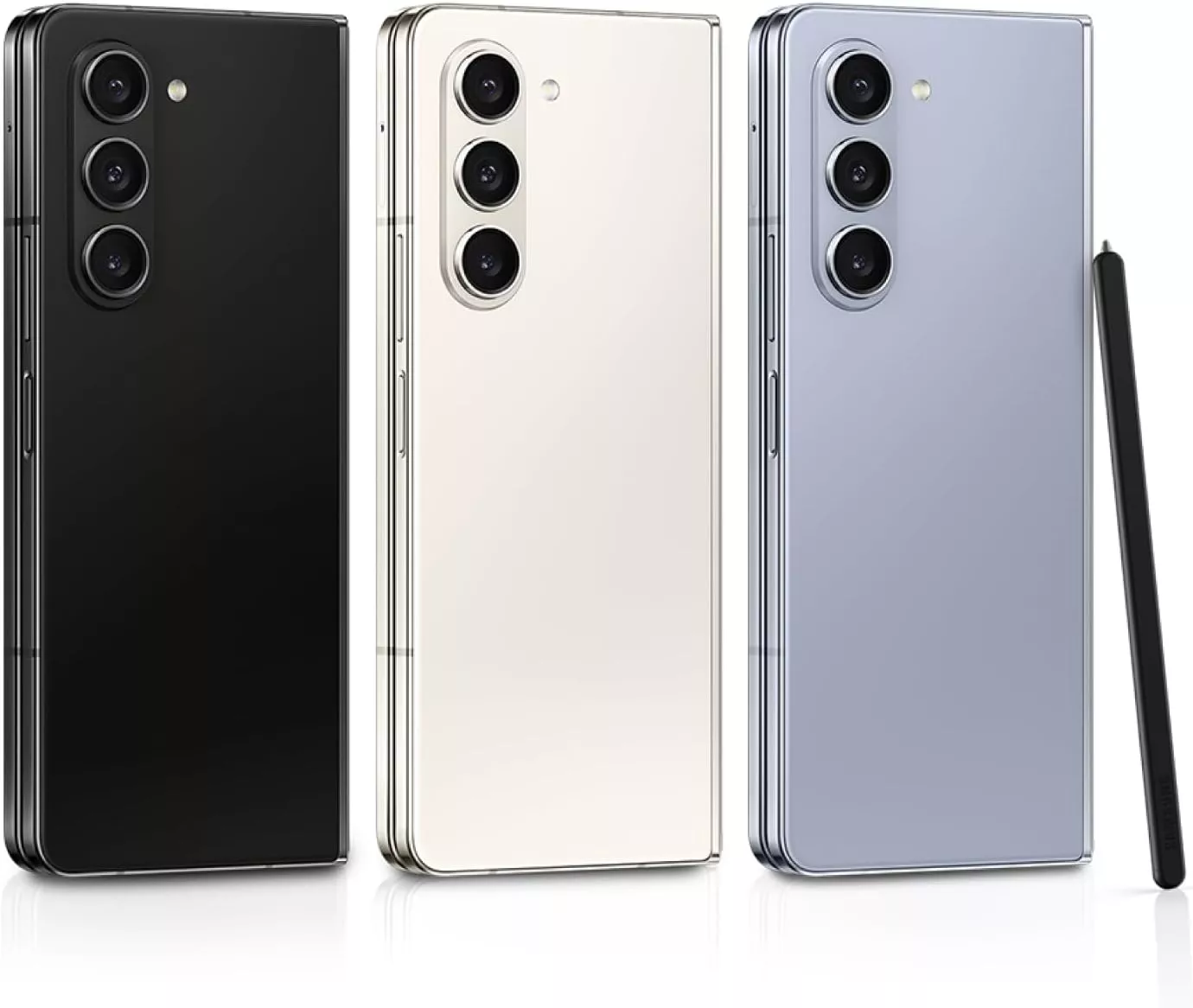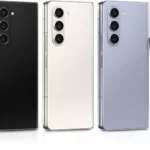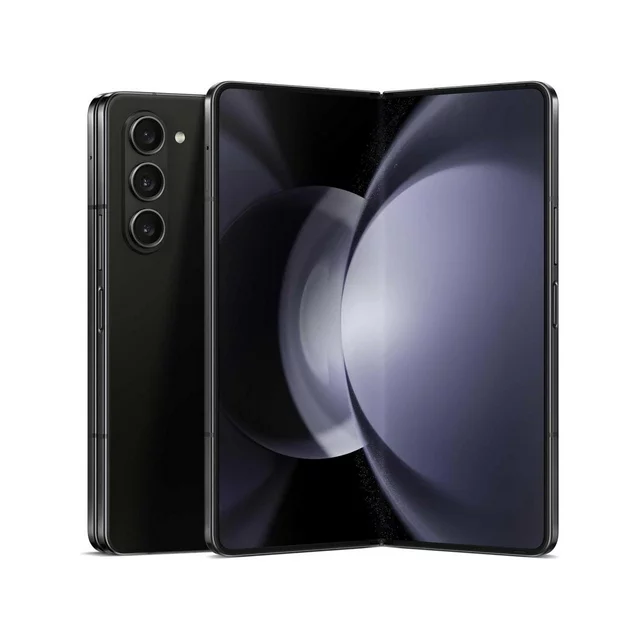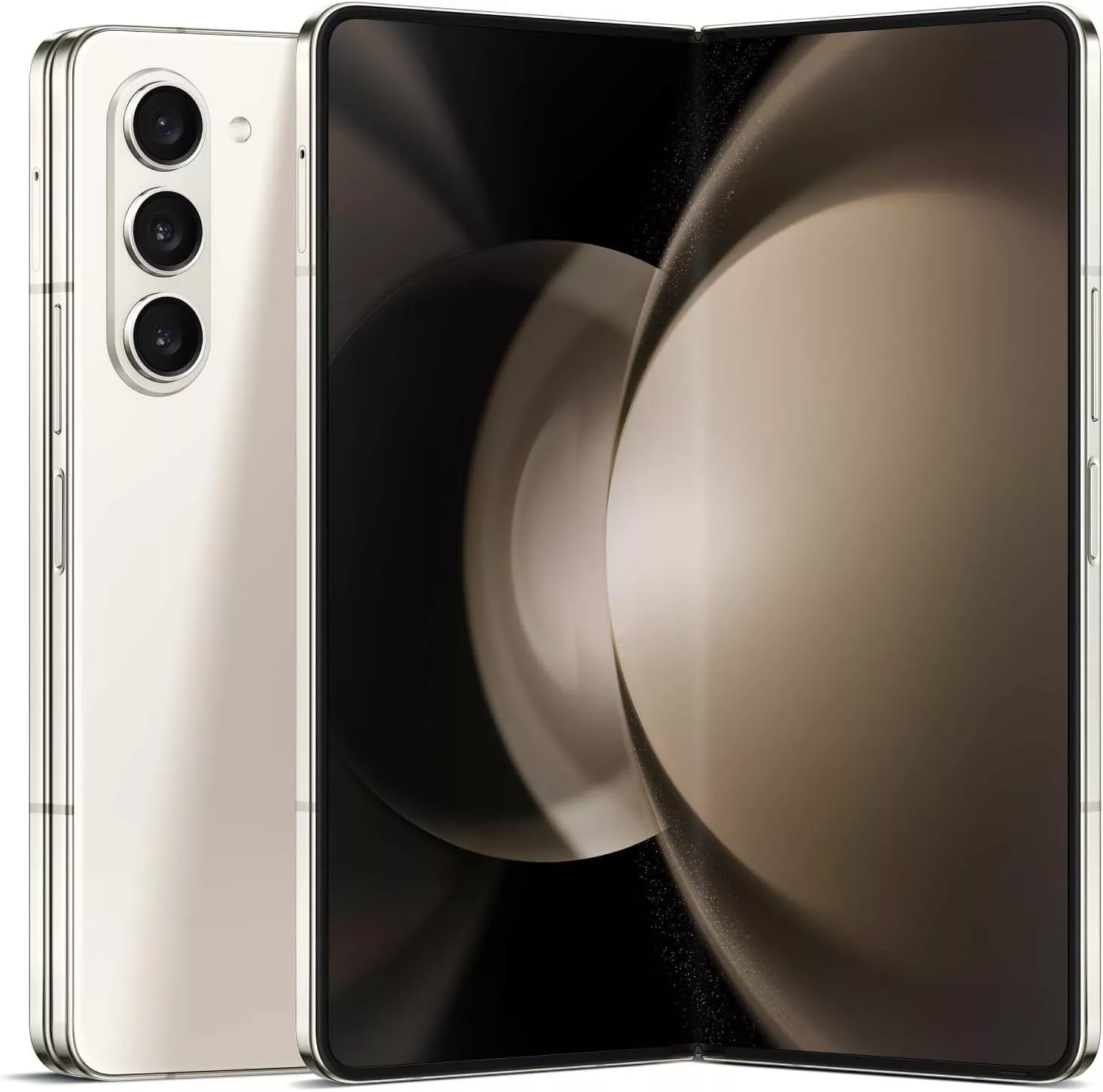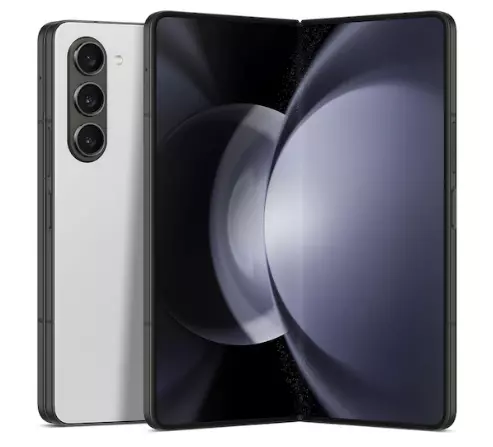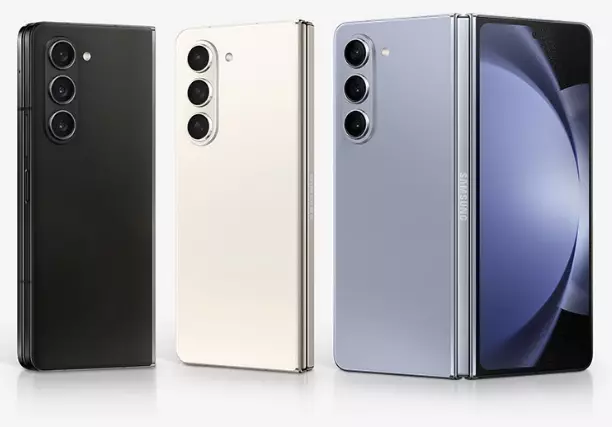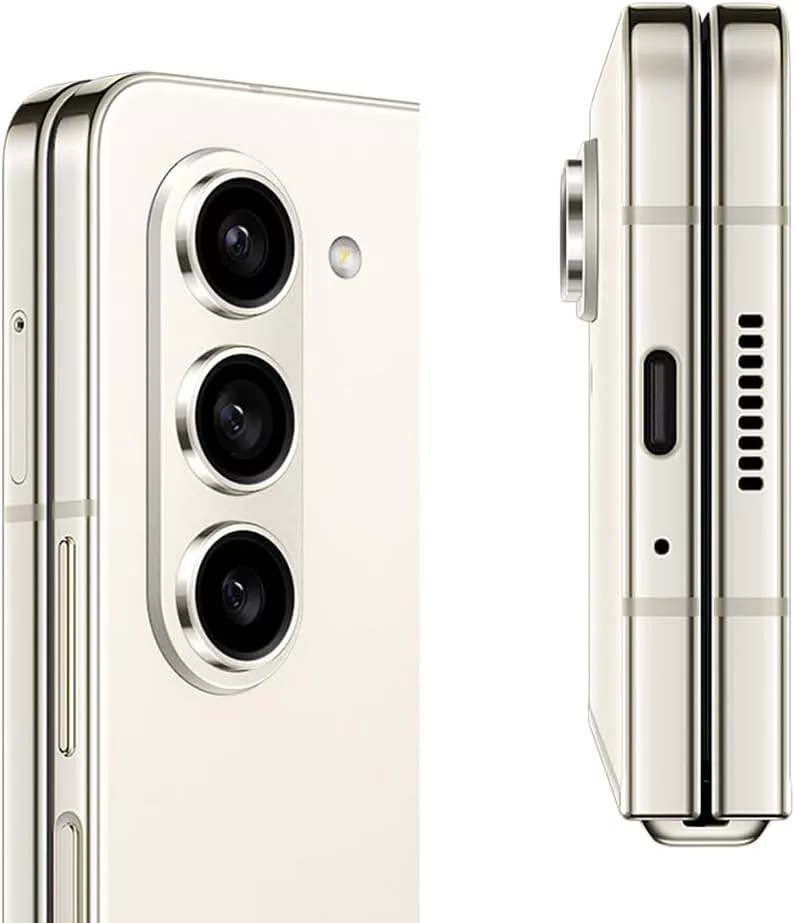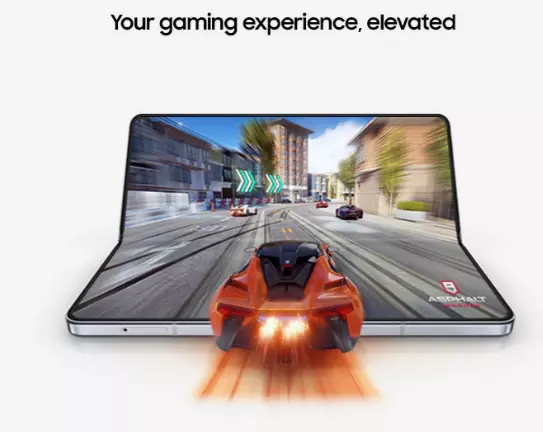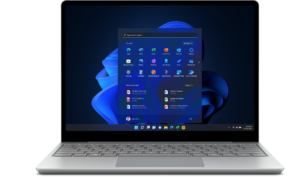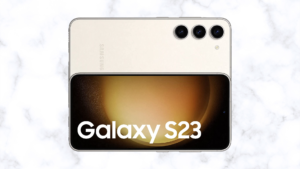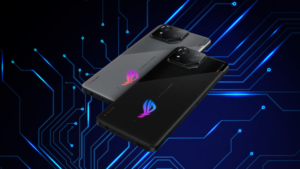Samsung Galaxy Z Fold 5
The Samsung Galaxy Z Fold 5 smartphone is one of the best to release this year. But with a high price tag and visible crease on the larger display may leave many potential buyers looking elsewhere.
Specs
| DISPLAY | MAIN: 7.6 inches, Dynamic AMOLED 2X, 120Hz, HDR10+, 1812 x 2176 pixels | COVER: 6.2 inches, Dynamic AMOLED 2X, 120Hz, 904 x 2316 pixels |
| CHIPSET | Snapdragon 8 Gen 2 CPU (4 nm) | Adreno 740 GPU |
| STORAGE MEMORY | 256GB 12GB RAM | 512GB 12GB RAM | 1TB 12GB RAM |
| OS | Android 13, One UI 5.1.1 |
| CAMERA | 50 MP (wide) | 10 MP (telephoto), 3x optical zoom | 12 MP (ultrawide) | SELFIE: 4 MP (wide) | COVER: 10 MP (wide) |
| VIDEO | 8K@30fps, 4K@60fps, 1080p@60/240fps (gyro-EIS), 720p@960fps (gyro-EIS), HDR10+ |
| MISC | Fingerprint (side-mounted), accelerometer, gyro, proximity, compass, barometer | Samsung DeX (desktop experience support) | Ultra Wideband (UWB) support |
| BATTERY | Li-Po 4400 mAh | 25W wired | 15W wireless | 4.5W reverse wireless |
Table of Contents
The Samsung Galaxy Z Fold 5 – Overview
The Samsung Galaxy Z Fold5 is a seamless device with a Snapdragon 8 Gen 2 for Galaxy processor and Gorilla Glass Victus 2 on the front and back. However, the foldable market might make a significant jump from the little move taken by the Fold range.
The gap-free body of the Galaxy Z Fold5 finally matches the competition and solves one of the lineup’s biggest problems: the ugly and unusable V-shaped gap when folded shut. With its IPX8 certification, it is still only equaled by the Huawei Mate X3, whose Armor metal frame and Victus glass exterior are the most reliable on the market.
For the Galaxy model, the processor has been improved to the Snapdragon 8 Gen 2 with faster CPU and GPU speeds, and storage has been increased to UFS 4.0.
The remainder is copied and pasted from Fold4. The 7.6-inch Dynamic AMOELD 2X screen with 373ppi, 120Hz dynamic refresh rate, and HDR10+ is still a foldable AMOLED panel. It supports S-Pen input and includes a sophisticated 4MP camera hidden behind the display to prevent disruptions. Despite not being a component of the phone itself, the new, smaller S-Pen cover may be one of the most significant enhancements we receive this year.
The same 6.2-inch Dynamic AMOLED panel with 120Hz refresh rate and HDR10+ is available externally. While there is no S-Pen support, there is a punch hole here.
Another feature that was directly copied from the Fold4 is the back camera configuration. The new Snapdragon chipset will be hoped to assist the 50MP OIS main, 12MP ultrawide, and 10MP OIS 3x telephoto combination in enhancing image quality with its processing power.
Battery life is another area that can only be improved by the new chipset as the Fold5 has a 4,440mAh battery with 25W wired and 15W wireless charging capability.
It was undoubtedly written on the wall in the Fold5 R&D labs, “If it ain’t broke, don’t fix it.” Although the unsightly gap is gone, the Fold5 still appears to be a makeover rather than a completely new design. Imagine a Galaxy Fold 4s.
Could there possibly be more to this new phone than first appears? Has Samsung concentrated on internal changes that enhance the user experience but don’t appear on the specifications sheet? Let’s investigate by taking a look inside the box.
Design
- Thinner, lighter and easier to hold
- Same design as previous model
- Comes with water resistance
- Build using quality materials
The design of the Samsung Galaxy Z Fold 5 is clearly the result of iterative development. It shares a lot of similarities with the Galaxy Z Fold 4 at first appearance, but there are also significant and, in my opinion, positive distinctions.
With a weight reduction of about 11 grams over the previous generation, the Z Fold 5 is much lighter. Additionally, it weighs 30 grams less (252 g) than the substantial but superb Google Pixel Fold (402 grams).
More significantly, the glass-covered frame made of polished aluminum and Gorilla Glass Victus 2 can now be folded flat. When folded, the smartphone is substantially lighter and slimmer thanks to it and the millimeter of body thickness. It also feels good in your hands.
Samsung redesigned the hinge and the way the flexible display is bent inside it when you close the phone. However, the sweeping technology that was added to the hinge mechanism a few years ago to keep out crumbs and dust is still present.
The flexible display crease seems to have become significantly less obvious thanks to its improved hinge. Although it’s still visible and perceptible, it seems a little less obvious.
Most button and port locations are the same. On the top and bottom edges of the phone, there are speaker grills that are marginally smaller than those on the Z Fold 4. On the bottom, near to a microphone connector, is a USB-C port.
A single air vent and two microphones are located on the top. If the phone is open and the main screen is facing you, the physical SIM slot is on the left edge, while the power/fingerprint reader and volume rocker controls are on the right.
The fingerprint reader is one of two reliable biometric security choices, by the way. You may use the fingerprint reader or register your face to unlock. It’s simple to setup the security features with your face or pin code, and unlocks your phone quite quickly.
The hardware of the cameras, all five of them, has not changed from the Z Fold 4, however the back camera array has undergone a minor aesthetic adjustment. Samsung appears to have removed some metal from the aluminum island that encloses the three back lenses. The LED flash has also been relocated from the island and put close to the lens array.
Otherwise, nothing has changed. In comparison to the Fold 3, I loved the previous design and was pleased to see that Samsung was able to significantly widen the cover screen without expanding the phone chassis.
As soon as I open the Z Fold 5, I can clearly see the edge-to-edge screen, and it appears to be bigger. Samsung’s primary camera is cunningly concealed behind the primary foldable display and only becomes visible as a cutout when in use.
The way the hinge works is strong and slick. Despite hundreds of instances of opening and closing, the phone still felt secure when I first used it and still does. This Android phone is wonderfully made. In reality, I can attest from personal experience that Samsung is thorough and does not tolerate flaws in its Galaxy devices.
Without a doubt, the Z Fold 5 smartphone is beautiful from an aesthetic standpoint, with its polished, color-coordinated frame reminding one of a fancy bag or briefcase’s clasp. My favorite and the Fold 5’s distinctive color is Icy Blue. Other colors are available, such as Phantom Black, Cream (exclusive from Samsung.com), Gray, and Blue.
You can see sandwiched, polished aluminum, colorful glass on the back, and a big cover screen when it is folded shut. Despite having more thickness than a typical candy bar smartphone, it feels sturdy without being heavy and fits well in virtually any pocket.
One of the most robust foldables, it can withstand being submerged in water for 30 minutes thanks to its IPX8 certification. But that only applies to fresh water, not the salt water found at beaches. If you do take it to the beach, try not to drop it in the sand because it isn’t especially dust-resistant and the moving components won’t like it.
I ran my Galaxy Z Fold 5 under the faucet, but I didn’t entirely immerse the phone. It was fully undamaged after I dried it off. The overall design of the Z Fold 5 is not anything new, but it does have better features.
Display
- Impressive displays both cover and main
- No changes to resolution, screen size and refresh rate
- Crease on main display is hardly noticeable
The 6.2-inch AMOLED (2316 x 904) outside display has a selfie camera with a punch-hole. It is responsive, bright, and angular. This cover screen has a customizable refresh rate of 48-120Hz, much like its predecessor.
The stated screen size can be a little deceiving. Yes, it is wider than the 6.12-inch display on my iPhone 14 Pro, measuring 6.2 inches diagonally, but it is also smaller. My iPhone 14 Pro and the Pixel Fold are both noticeably (almost half an inch) bigger.
Because of the tiny cover screen, this phone is still easy to carry even when it is folded to be twice as thick as the normal iPhone. But when compared to other smartphones, particularly the roomy Google Pixel Fold cover screen, it frequently feels constrained in usage.
Although the Pixel Fold showed me what was possible, I can no longer live with thumb typing on the too-narrow display of the Z Fold 5’s cover screen. And this is significant because, despite the fact that this is a dual-screen gadget with lots of productive potential, I spent a lot of time on the road with it folded shut.
The cover screen should be just as functional as the main screen, as it is on the Pixel Fold, but it isn’t, at least not in comparison.
When you unfold the phone, a stunning 7.6-inch small tablet display is revealed. Dynamic AMOLED 2X panel, 2176 x 1812 resolution (374ppi), and 1-120Hz adjustable refresh rate are its perfect specifications and resolution. Having said that, this is an excellent display for browsing websites, checking email, and perusing social media.
While utilizing the display to play games, watch Netflix, shoot photographs (using it as your big-screen viewfinder), and manage numerous applications at once, you won’t notice the flexible screen crease (even if it appears a little less obvious).
Even though it has a slightly lesser resolution and pixel density (the Pixel Fold has a 2208×1840 OLED at 380ppi), this screen is more than comparable to the Pixel Fold’s. I like how the Z Fold 5’s screen extends all the way to the edge and how Samsung chose to conceal the internal front-facing camera behind a sparse patch of pixels that it can switch off when not in use rather than utilizing a larger bezel.
I don’t understand why Samsung chose to stick with the 4MP camera rather than switching to a better resolution sensor (like what you’ll find on the Pixel Fold), but at least the 7.6-inch foldable display is excellent.
The display’s advertised 1,750nit peak brightness (our lab testing hit 1,350nits in HDR mode), which I frequently used outside, was more than adequate of blocking out direct sunlight.
The phone’s displays are both touchscreens, of course, but the folding display has the advantage of accepting pen input via Samsung’s S Pen stylus. Samsung provided the new $99 / £99 Galaxy Z Fold 5 Slim S Pen cover, which is itself a pretty interesting feat of engineering, as the phone doesn’t come with one. Just above the stylus, there is a tiny S Pen release. I just depress the button to release it, and the S Pen emerges from the casing.
If I’m being really honest, I don’t like how thin the newest S Pen is. Having saying that, I liked using it on the primary display. With applications like Sketchbook, it’s fantastic for taking notes quickly and even sketching. There isn’t a better option, in my opinion, if you’re considering purchasing a case for your new Z Fold 5, than one that also contains this pen.
On the huge primary display, everything appears to be in fantastic condition. It’s ideal for my passion with Asphalt 9: Legends and for viewing movies on the train. Its flexibility also makes it versatile.
With a screen the size of a tablet, multitasking is an option. I had no issue dragging and dropping up to three applications into place to launch them. I can press the ellipsis in the middle of my trio of applications to switch between the three places.
You might wish you could open more applications at once, but I believe three is sufficient for readability and functionality. Drag and drop operations between these two displays are similarly simple. In this case, having one app on the left and another on the right makes sense (for example, mail on the left and photos you want to drop in on the right).
Soon after receiving my review sample from Samsung, I made the decision to rely only on the Galaxy Z Fold 5 to direct me as I walked from a restaurant back to my hotel in Seoul. I launched Google Maps on the 7.6-inch display after unfolding the phone and started looking for my accommodation.
Maps located it and could pinpoint my location and travel direction with a small blue dot. Because Maps couldn’t produce walking instructions in South Korea, that was useful. I only needed to stroll while keeping an eye on my blue dot on the large screen. I was back in my hotel room in fifteen minutes.
I can sit the phone on the table, fold the screen 90 degrees, and watch movies on one side of the screen while scrolling through my photographs and videos or use Flex Mode to shoot shots by waving at the screen. The Z Fold 5 also functions as a tripod by itself.
I would set it down on a chair, table, or other flat surface, point the back cameras at my subject (people, the sky, the stars), and then use the settings on the screen to snap the picture either right away or, if I didn’t want to take the chance of moving the phone, on a timer. Hyperlapses of stars moving over the night sky and groups of people passing by are both fantastic subjects for this kind of video.
There isn’t a “Tent Mode” on this device as there is on the Pixel Fold, which would allow you to half unfold the phone and play content horizontally on the Cover screen. Given how little that monitor is, this is definitely reasonable.
Camera
- No drastic changes from Z Fold 4
- Impressive photo and video quality
I can see the plan with the Z Fold 5 even though it’s rare for a phone maker like Samsung to keep all of its cameras the same from one model to the next. Few individuals own foldable phones or have purchased the Z Fold 4. Do you see many individuals sporting them at the park or on the train as you look around? Exactly.
Samsung has a point when it says that the Galaxy Z Fold 5 (or its sexier sibling, the Galaxy Z Flip 5) may be customers’ introduction to foldable phones. With one exception, the Z Fold 4’s camera collection was pretty strong. It’s doubtful that you won’t like what Samsung has to offer in this area.
Given the fact that options for foldable phones are expanding at an exponential rate, there is obviously a concern. Don’t even get me started on the abundance of folding alternatives available to customers in the UK and Europe (entry from Oppo, Honor, and Huawei come to mind); it’s been a while since I evaluated the Z Fold 4. Google introduced the Pixel Fold since I last reviewed the Z Fold 4, and it does, in some respects, surpass the Z Fold 5’s photographic capabilities.
With a 5x optical zoom compared to Samsung’s 3x magnification, Google excels above Samsung in this specific area. Although Samsung may brag about its remarkable 30x spatial zoom capabilities, images shot with that digitally enhanced feature don’t hold up all that well when compared to other cameras. Additionally, part of the graphics combines actual images with what AI knows about your subject. That, in my opinion, is not true photography.
Nevertheless, I had a great time utilizing the Z Fold 5’s cameras. In certain circumstances, the images and portrait mode photographs are amazing. The tendency of Samsung to intensify the colors largely works in its advantage. I do enjoy a sky that is even more spectacularly blue and more purple flowers. Although authenticity may not be Samsung’s strong te, I believe everyone will like your Galaxy Z Fold 5 pictures.
The Qualcomm Snapdragon 8 Gen 2 delivers superior picture processing, which I saw on exhibit in the great low-light night photography, despite the fact that Samsung didn’t alter the sensors. The pictures are pretty good, whether they were taken in a restaurant where a 20-course Korean meal was being served or of the lovely Seoul cityscape.
Even when taking pictures in portrait mode, the camera is quick. I photographed several people who were learning to juggle, and I was astounded by the primary 50MP camera’s ability to not only capture the jugglers in action but also to recognize the balls in flight and bring them into focus alongside my subject.
My argument is that, if you have a decent lens and sensor, sometimes all you need to do to improve speed and image processing is upgrade the silicon. I took the majority of my Samsung Galaxy Z Fold 5 photos with the phone closed, utilizing one of the three rear cameras as my viewfinder and the cover screen as a flash.
The main screen is accessible if I open the phone, but it’s a little cumbersome. I could utilize the greatest cameras on the phone, the 10MP cover display camera (recommended), the 4MP folding display camera (not recommended but fine for video conferencing), or both for a selfie.
I did this by unfolding the phone and choosing the “Cover Preview Screen” icon in the camera app’s upper right-hand corner. Due to the back camera array facing me, I was able to utilize the cover screen as my viewfinder. By moving the lock icon on the cover screen to the left or right, I could even have complete control over all photographic functions.
This is because, whether you’re shooting conventional photos or selfies, you can shoot using the phone’s greatest camera system. Although it’s a good feature, I didn’t like photographing with my phone unfurled in general since I was afraid of dropping it.
I also recorded some video, up to 8K 30fps, and was happy to see that there was no stuttering while recording or playback. However, I do believe that the playback of the 4K 60fps video is a little bit more buttery smooth. In either case, this phone can record some excellent films.
The auteurs among us have the option of shooting in Pro video mode, which offers them full control over the camera’s settings, including focal point, speed, and microphone (omnidirectional rather than simply front or rear, or even an external microphone).
Even while Samsung sometimes tucks away useful features inside the “More” menu, its Camera app is generally richer than Apple’s. You may select “Pro” (under More) for manual control. Additionally, you may capture 12MP stills (by merging four pixels at a time) or 50MP raw pictures with the free Samsung Expert Raw program.
You can adjust every manual option on your camera with it as well. Although it’s still a mystery to me why these phones don’t come with Expert Raw pre-installed, at least it’s available.
Compared to Apple, Samsung often provides you more control over camera functions. Similar to Apple’s Timelapse, Hyperlapse has six settings and explains how to utilize each one (300x is ideal for observing the stars, for instance).
Performance
- Same chipset from the S23 series smartphones
- Impressive performance
- Base model starts at 12GB of memory and 256GB of storage
- Impressive gaming graphics
Samsung may not have made many changes to the cameras or other parts of the Galaxy Z Fold 5, but it changed the important parts. There is the still-new Qualcomm Snapdragon 8 Gen 2 ‘for Galaxy’ SoC, which is now also included in the complete Galaxy S23 series. This slightly overclocked version of the CPU.
Twelve gigabytes of (LPDDR5X) RAM support that. Together, they contributed to a simple and enjoyable user experience.
According to the results of our Geekbench 6 testing, Qualcomm’s silicon outperforms the Tensor G2 CPU in the Google Pixel Fold in terms of single-core performance (2050 vs. 1179) and multi-core (5302 for the Z Fold 5 vs. 3759 for the Pixel Fold). The Z Fold 5 fared nearly twice as well as the Pixel Fold in one of our OpenGL tests that measures graphics performance.
The majority of top-tier mobile chipsets, however, are more than quick enough for almost everything you might imagine doing with a smartphone. In other words, while most common and more demanding video and picture editing operations seemed similarly quick on the Z Fold 5 and Google Pixel Fold, it is in prolonged usage that the extra overhead provided by the Samsung device shows out.
I raced around San Francisco in Asphalt 9: Legends while playing Call of Duty Warzone Mobile at the maximum visual quality and framerate possible without any tearing or stuttering. I also used PowerDirector to simultaneously edit multiple 4K video streams (I notice that most mobile video editors are unable to edit the 8K footage). This portable is equipped to handle almost everything.
This is a 5G phone, so it goes without saying that I experienced strong connections and quick downloads in areas with decent coverage. Both an eSIM and a conventional SIM are supported. Excellent performance in the workplace and at home as well as decent future-proofing were made possible with Wi-Fi 6e support.
Battery Life
- No change to battery from the Z Fold 4
- Supports fast wired, wireless, and reverse wireless
Samsung didn’t adjust the battery size between the Z Fold 4 and Z Fold 5. The Pixel Fold has a battery capacity of 4,727mAh and weighs 30 grams more than the Z Fold 5; this means that 4,400mAh is less than the Pixel Fold.
Samsung claims its devices would have all-day battery life, and I regularly experienced this. On most days, it was used for at least 15 hours.
The phone is compatible with Samsung’s version of “Super Fast charging,” which recharges 50% in 30 minutes. In our experiments, a 65W power adaptor allowed us to recharge to 56% capacity in 30 minutes.
However, just the USB-C cable is included in the package, so if you want to charge your device as quickly as possible, you’ll need to purchase one of those appropriate 65W or 45W adapters.
On several Qi wireless chargers, I was also successful in charging my device. When activated in Settings, the phone also enables wireless PowerShare, allowing you to stack Samsung phones on top of one another to transfer battery power between them (or to earphones or a compatible timepiece).
Verdict
The Samsung Galaxy Z Fold 5 is a significant improvement to the Z Fold 4, giving the foldable smartphone formula a flatter and lighter design. It has sufficient power, adaptability, and premium parts and materials.
However, the identical features to the older model, the Z Fold 4, such as the battery, chipset, the camera system and the little cover screen fall short when compared to the considerably broader competitor, such as the Google Pixel Fold. At least it’s better than the older Z Fold 4.
Should you buy it? Yes you should, if you can afford it. Although the Z Fold 5 is coming at a high price, it tick all the right boxes. So if you work in corporate, then this your ideal smartphone.
Any comments are welcome here below. If you also have questions then, leave them also below and I’ve get back to you soonest. If you want to find out more about this amazing smartphone, click here.

